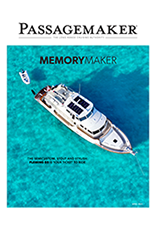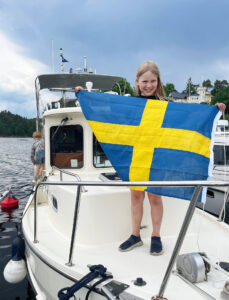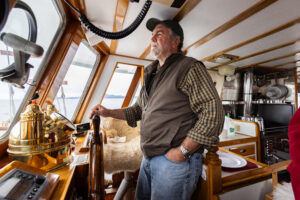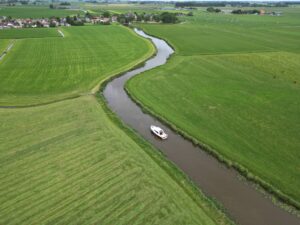Bob and Sue Keehne had the boat, they’d soon have the time, but they weren’t entirely sure they had the skills or confidence to take on the Great Loop. They’d owned small sailboats over the years and had done some light cruising in their home waters of Lake Michigan, but a journey of more than 5,000 miles that would take them up and down unfamiliar rivers, through numerous locks and across exposed sections of the Gulf of Mexico and the Atlantic coast would test them on many levels.
Their fears about all that changed, though, when they attended an event hosted by the America’s Great Loop Cruisers’ Association. Loopers presented several days of seminars on practical topics such as anchoring and navigation. The Keehnes went home confident they were up to the task.

“That was the turning point that convinced us,” Bob says.
A year and a half later, they cast off from their home port of Ludington, Michigan, on an adventure that would take them on a 5,642-mile counterclockwise circumnavigation of the eastern third of the United States via the more popular Great Loop routes. With an eight-month interruption courtesy of the Covid-19 crisis and one trip home to spend the holidays with family, they crossed their wake two years and one month later. For a couple in their late 70s, married 57 years, with little serious cruising experience, the trip wasn’t without challenges, but they met them head-on and soaked up everything—and everyone—they could.
After the relative calm of the river systems, the exposed portions of the Gulf and the Eastern Seaboard provided some more formidable challenges. They weren’t navigating at night, but they did experience some rough conditions in open water as they moved along the coastlines.
In his younger days, Bob spent four years as a mechanic in the U.S. Coast Guard. When he was out, he and Sue settled in Charlotte in central Michigan, and started a family. Twelve years later, they bought a cottage in Shelby on the state’s Lake Michigan shore about 30 miles north of Muskegon, and eventually opened a plumbing and hardware store.
Over the years, they owned a sailing dingy and a Hobie 16, which they sailed off the beach with their daughters as they grew up. When their kids were in their late teens, they bought a 30-foot Catalina sailboat and cruised casually when their busy hardware store schedule allowed it.

“Three days off to us was spectacular,” Bob says. “We never really traveled much.”
As they began to think about retirement, they thought they might want to ramp up their cruising and began to shop casually for a boat better suited for the mission. One day while they were at a yard buying parts for the Catalina, a boat on the hard caught Bob’s eye. He got out of the car and took a closer look, but Sue declined. The next year, they encountered the boat at anchor. Sue was still cool on it, but it had her attention.
“I believe her words were, ‘That damn boat is haunting me,’” Bob says.
Two more years went by and the haunting continued, still more for Bob than for Sue. They started asking around and found it again in upper Michigan.
“It was calling to one of us, and it wasn’t my wife.” Bob muses.
“I told him we didn’t deserve such an ugly boat,” Sue says.
The boat was, indeed, a bit of an oddball: a custom-built, 40-foot steel hull with a flush deck and an A-frame, foldable sailing rig. Bob refers to her spartan interior as a “full basement,” but he saw promise in her as a cruising powerboat. Her name was Osimo, which Bob says means “escape” in Chippewa or Ojibwe. They pulled the trigger and brought her home.
Osimo took up residence in the grass behind Keehne Plumbing & Hardware for the next nine years, during which she underwent a major transformation, still with relaxed, but more extensive cruising in mind. The Loop was not yet on their radar.
Osimo was built custom by Vinette Boatworks in Escanaba on Michigan’s Upper Peninsula. She was essentially a shell with an 85-hp, four-cylinder Perkins diesel. Bob set about fabricating a proper salon and pilothouse from steel above the flush deck. With occasional help from friends, the Keehnes gutted the interior and finished out the space with two staterooms, two bathrooms, a galley, a washer/dryer and a generator. They kept the unusual 6-foot-wide “picture window” in the transom, which now provides light and views to the master stateroom.

The hardware store being steps away didn’t hurt the project, with high-quality materials available to them at cost. The interior joinery is oak, cedar and pine sourced through the store, done in tongue-and-groove classic style. Employees and friends often helped them with the project, and the local community was always on hand to offer advice and track progress.
Bob describes himself as a bit of a Luddite, but he didn’t demure when it came to equipping the boat for the Loop. “I’m a vanilla person in a chocolate Goo Goo Cluster world,” he says. He fitted out Osimo with Raymarine electronics including autopilot, radar and plotter, and VHF radio, supplemented by two iPads and a portable Garmin GPS.
The couple discovered the existence of the Loop a few years before completing the refit. Through friends, they began to network with Loopers, and their interest in doing it began to percolate.
“I’d never heard of it before,” Bob says. “As time progressed, it just kind of came into play. We said, ‘Let’s do this and see what happens.’”
Whatever misgivings they had about such an undertaking were allayed after they attended the America’s Great Loop Cruisers’ Association event. They set out from their home port of Ludington on September 5, 2019, bound for Chicago and points south, east, north and west.
The Loop provided the Keehnes their share of new challenges and boating experiences. Unlike their home waters, where the depth simply increases as you move off the beach and the bottom is sand, the rivers tested them. They’d never transited locks before, but they quickly figured out the drill. Small-scale locks near Chicago gave way to towboat-scale, 65-foot walls. The Mississippi River was high when they went down, and Osimo well exceeded her 6- or 7-knot cruising speed. With their 5-foot draft and the steady towboat traffic, the need for constant vigilance prevailed.

“When you get into the river system, you have to really pay attention to what’s going on all the time,” Bob says.
Like many Loopers, they left the Mississippi at Cairo, Illinois, turned up the Ohio River and entered the pair of large impoundments that define the eastern boundary of the Kentucky portion of the Jackson Purchase. From there, it was up the Tennessee River, down the manmade Tennessee-Tombigbee Waterway, into the Tombigbee River proper and out into the Gulf of Mexico at Mobile, Alabama.
After the relative calm of the river systems, the exposed portions of the Gulf and the Eastern Seaboard provided some more formidable challenges. They weren’t navigating at night, but they did experience some rough conditions in open water as they moved along the coastlines. Bob proposes that Osimo’s deep draft, full keel and 42,000-pound heft served them well when the wind and waves fired up.
“It handled that a lot better than I thought it would,” Bob says. “I think it was the weight doing the talking.”
They did encounter some issues with the draft as they made their way down the west coast of Florida, touching the sandy bottom of the Intracoastal Waterway occasionally, once hard enough to need a tow off. A bigger obstacle presented itself after the couple settled into a marina in Marathon, Florida, in January 2019 for an extended layover in the Florida Keys.
“We had a reservation to spend three months in the Keys, and lo and behold, Covid came along and put a squash on our plans to move on,” Sue says. Four months passed, and things weren’t getting better for traveling, so they put the boat in storage and headed back to Michigan.

Eight months back home allowed them to catch up with family, but it didn’t scuttle their desire to complete the Loop. They returned to Marathon at the beginning of 2021, resumed their original plan to spend a few months there, and started working their way up the East Coast.
The run north was not their favorite part of the journey. Some rough conditions in exposed waters along the way and the traffic in the ICW, especially in the Carolinas, provided some annoyances. There were, however, highlights sprinkled in: seeing a Navy submarine steam past in the James River in Virginia, and witnessing a nighttime rocket launch while anchored in Titusville, Florida.
“It’s the random things that happen that are good,” Sue says. “We don’t get to see that in Michigan.”
Their favorite part of the trip, though, was transiting the Erie Canal. Their original plan was to head up New York’s Hudson River to the canal, exiting into Lake Ontario at Oswego and doing Canada’s Trent-Severn Waterway. But the Covid border closing quashed that plan. Along the 363-mile Erie waterway, they met cruisers of all stripes. They helped each other in numerous ways, as did the locals along the route, creating even more memories than the locales.
“For me, it was the people we encountered along the way,” Bob says. “Whether they be boaters or non-boaters, the people were unbelievable to us.”
From the canal’s western terminus at Buffalo, New York, it was relatively easy sailing down Lake Erie, up Lake Huron, over the top of the Michigan peninsula and home to Ludington. They crossed their wake on October 4, 2021.
Bob would advise anyone considering doing the Loop to get off the dime and go for it.
“You reach a point where you have to throw the lines off and do it,” he says. “That’s what we did. I think we’re better people for it. It puts your faith back in mankind a little bit.

“It’s literally just a great adventure,” he adds. “It’s kind of like riding the train. You get to see everybody’s backyard. It’s just a great thing to do. Just take your time and chill out.”
Bob says he’d do the Loop again, but in a different boat. Osimo is listed for sale. The couple is considering a trailerable pocket cruiser with which they’d take more compact, hit-and-run trips such as the Trent-Severn. They say that they’d also like to see more of their home state by water.
Perhaps most important, the time they spent in close quarters on their Loop adventure did not imperil their 57-year marriage.
“We live in a very small house, but to me, it seems enormous now,” Bob says.
“It still gets dusty though,” Sue adds.











